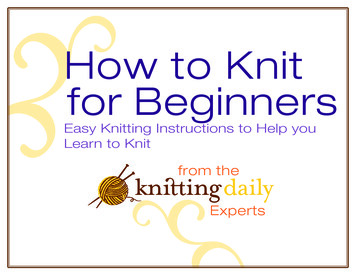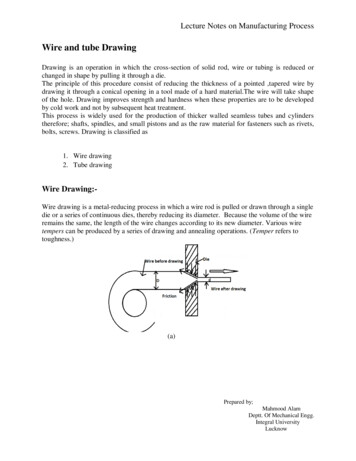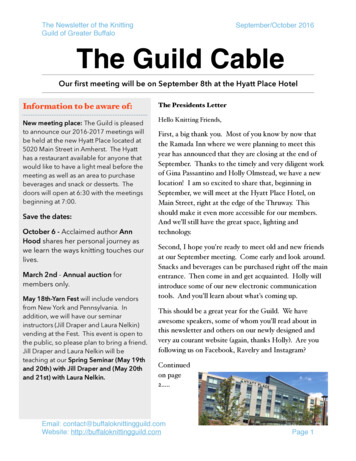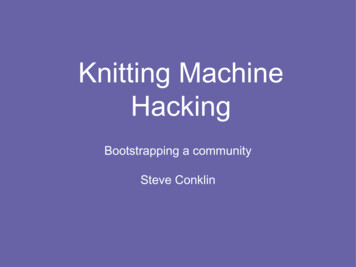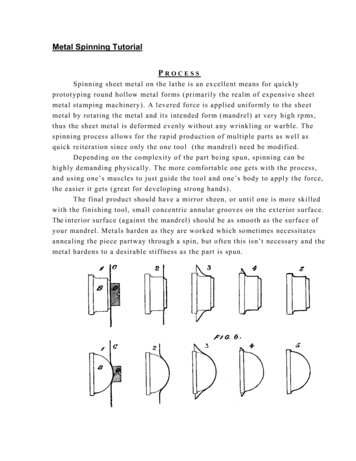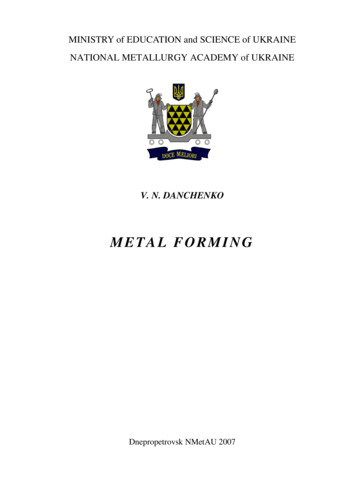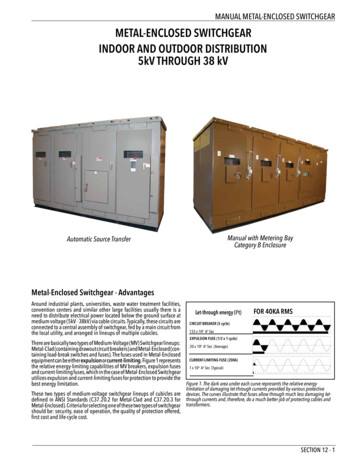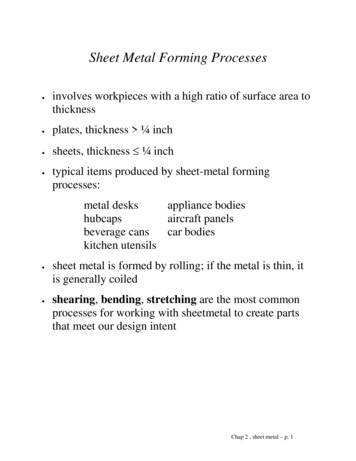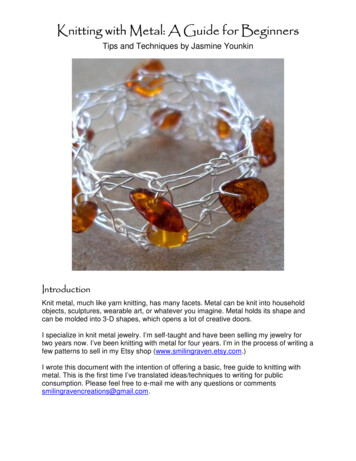
Transcription
Knitting with Metal: A Guide for BeginnersTips and Techniques by Jasmine YounkinIntroductionKnit metal, much like yarn knitting, has many facets. Metal can be knit into householdobjects, sculptures, wearable art, or whatever you imagine. Metal holds its shape andcan be molded into 3-D shapes, which opens a lot of creative doors.I specialize in knit metal jewelry. I’m self-taught and have been selling my jewelry fortwo years now. I’ve been knitting with metal for four years. I’m in the process of writing afew patterns to sell in my Etsy shop (www.smilingraven.etsy.com.)I wrote this document with the intention of offering a basic, free guide to knitting withmetal. This is the first time I’ve translated ideas/techniques to writing for publicconsumption. Please feel free to e-mail me with any questions or commentssmilingravencreations@gmail.com.
PreparationFirst things first, learn how to knit using yarn. Many of the techniques used in yarnknitting can be transferred to knitting with metal. There are some techniques and trickswhich are unique to metal knitting.Next step, trim your nails as much as possible. Knitting with metal *WILL* break yournails. I usually coat my nails with Hard as Nails or some comparable strengtheningpolish. Beat the inevitable by preparing.Invest in some nice hand cream. For whatever reason, working with metal dries out myhands much more than working with yarn. Make sure you moisturize at least 15 minutesbefore so the metal doesn’t slip between your fingers. I prefer moisturizers with noscent. Sometimes artificial scents will dull metal or simply smell putrid when mixed withmetal smells.Invest in a good set of needles or two. I’ve found that aluminum work best for me. Steelneedles will also work. I wouldn’t suggest using bamboo or wood needles for obviousreasons. They break easily and the metal wears them down, causing painful splinters.Your aluminum needles will get bent and funky. They won’t be pretty, but will stillfunction fine for metal working. They’re also easy to bend back into shape when theyget arched.I personally prefer dpns. They come in sets of 4-5 needles, so I can have more than oneproject going. They also tend to be shorter and compact. When you’re working withmetal, the work will strain your fingers and hands. Working with smaller needlesreduces the amount of work you’ll have to put into knitting. Short needles will also bendless than long needles. I generally use 6 inch aluminum dpns.
The WireWhen first starting out, I suggest using cheap, throw away wire. You’re going to messup a lot when you first start out. Unlike yarn, metal is very hard to deconstruct andrework – especially precious metals.I think 28 gauge wire is the easiest to use. I began knitting with cheap copper plumber’swire, which is great for candle holders and other miscellaneous creative projects.However, plumber’s wire can be a bit stiff. I would suggest investing in some low cost28 gauge copper jewelry wire. Make sure to buy pure copper, not coated. I can buy aspool of copper wire for about 6 US at the local craft store. 50 feet (15 meters) canmake a few small projects.There are three basic types of jewelry wire: soft, half hard, and hard. Hard is brittle andhard to work. Hard is VERY uncomfortable for anything wearable. Soft is VERY soft andcan break very easily. Soft is perfect for wearable projects, but takes a high level of skillto work. Half-hard is the perfect middle ground. Half-hard is malleable, durable, andworkable. Half-hard is the perfect material for beginners.MaterialsHalf-Hard WireAluminum Size 3 DPNsNeedle Nose OR Round Nose pliersJewelry Wire Cutters
CastingCasting OnCast on using lark’s head knot. There are other methods which are possible, but this isthe easiest method. Next, cast on additional stitches using preferred cast on method.Personally, I prefer the long-tail cast on method, but any method is fine.When casting on additional stitches, form a 1 inch (2.5 cm) loop. Gently decrease theloop, forming a nice even stitch on the needle. If the stitch is lopsided, release the stitch,smooth the wire, and start over.Cast on loosely. You’ll want approximately 2 mm (1/10 inch) of extra room on eachcasted stitch. Learning to cast on metal stitches is the hardest metal knitting technique.Once you’ve mastered casting on, you’re halfway there.KnittingSlip the first stitch onto the end of the cast on needle. Knit into the first stitch and whileboth needles are in the stitch, gently pull away from the first needle with the workingneedle. The stitch should fit on the working needle, leaving approximately 2-3 mm ofworking room and look a bit stretched out and funky. This is a good thing!Knit into the remaining stitches as you would normally. Turn the work and knit into thefirst stitch. Tighten this stitch a bit more than the others, pulling gently to get that nicestretched out stitch. Keep repeating this method until you’ve made a few rows.Your work should look like a box or rectangle. At first, your work will look a bit scragglyaround the edges. Remember when you first began knitting with yarn? Remember allthe lumps, bumps, and weird pieces with one side significantly too long? You’re going tohave to go through the same process to master metalwork. As you get used to workingwith metal, your work will improve.
BeadsTo include beads in your work, place them on wire *BEFORE* casting on. As you’reworking with the metal, slip them in between stitches. You’ll have the most success ifyou place all beads on one side of the work, rather than both. Large seed beads aregreat for practicing.Etc.Working with metal is a difficult skill to learn, but is very rewarding. The possibilities arelimited by your imagination. While you’ll probably be frustrated in the beginning, projectsthat initially take 5-6 hours to complete will become 1 hour projects.Knit jewelry is wonderful because it can be produced quickly for gifts or special events. Ioften whip up something to go with a particular outfit or on a whim. Instant gratificationat its finest!Smiling Raven CreationsElegant Jewelry & Unique Patternswww.smilingraven.etsy.com
two years now. I’ve been knitting with metal for four years. I’m in the process of writing a few patterns to sell in my Etsy shop (www.smilingraven.etsy.com .) I wrote this document with the intention of offering a basic, free guide to knitting with metal. This is the first time I’ve translated id
